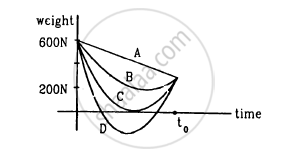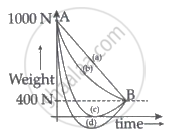Advertisements
Advertisements
प्रश्न
If heavier bodies are attracted more strongly by the earth, why don't they fall faster than the lighter bodies?
उत्तर
We know that acceleration due to a force on a body of mass in given by \[a = \frac{F}{m}\] If F is the gravitational force acting on a body of mass m, then a is the acceleration of a free falling body.
This force is given as \[F = G\frac{Mm}{R^2}\]
Here, M is the mass of the Earth; G is the universal gravitational constant and R is the radius of the Earth.
∴ Acceleration due to gravity, \[a = \frac{F}{m} = \frac{GM}{R^2}\]
From the above relation, we can see that acceleration produced in a body does not depend on the mass of the body. So, acceleration due to gravity is the same for all bodies.
APPEARS IN
संबंधित प्रश्न
Is there any meaning of "Weight of the earth"?
An apple falls from a tree. An insect in the apple finds that the earth is falling towards it with an acceleration g. Who exerts the force needed to accelerate the earth with this acceleration g?
The acceleration of moon with respect to earth is 0⋅0027 m s−2 and the acceleration of an apple falling on earth' surface is about 10 m s−2. Assume that the radius of the moon is one fourth of the earth's radius. If the moon is stopped for an instant and then released, it will fall towards the earth. The initial acceleration of the moon towards the earth will be
The acceleration of the moon just before it strikes the earth in the previous question is
Suppose, the acceleration due to gravity at the earth's surface is 10 m s−2 and at the surface of Mars it is 4⋅0 m s−2. A 60 kg passenger goes from the earth to the Mars in a spaceship moving with a constant velocity. Neglect all other objects in the sky. Which part of the following figure best represents the weight (net gravitational force) of the passenger as a function of time?

Take the effect of bulging of earth and its rotation in account. Consider the following statements :
(A) There are points outside the earth where the value of g is equal to its value at the equator.
(B) There are points outside the earth where the value of g is equal to its value at the poles.
Find the acceleration due to gravity of the moon at a point 1000 km above the moon's surface. The mass of the moon is 7.4 × 1022 kg and its radius is 1740 km.
A body is weighed by a spring balance to be 1.000 kg at the North Pole. How much will it weigh at the equator? Account for the earth's rotation only.
Explain the variation of g with latitude.
Explain the variation of g with altitude.
Explain the variation of g with depth from the Earth’s surface.
One can easily weigh the earth by calculating the mass of the earth by using the formula:
The earth is an approximate sphere. If the interior contained matter which is not of the same density everywhere, then on the surface of the earth, the acceleration due to gravity ______.
Which of the following options are correct?
- Acceleration due to gravity decreases with increasing altitude.
- Acceleration due to gravity increases with increasing depth (assume the earth to be a sphere of uniform density).
- Acceleration due to gravity increases with increasing latitude.
- Acceleration due to gravity is independent of the mass of the earth.
A person whose mass is 100 kg travels from Earth to Mars in a spaceship. Neglect all other objects in the sky and take acceleration due to gravity on the surface of the Earth and Mars as 10 m/s2 and 4 m/s2 respectively. Identify from the below figures, the curve that fits best for the weight of the passenger as a function of time.

If R is the radius of the earth and g is the acceleration due to gravity on the earth's surface, the mean density of the earth is ______.
If the radius of the earth shrinks by 2% while its mass remains the same. The acceleration due to gravity on the earth's surface will approximately ______.
